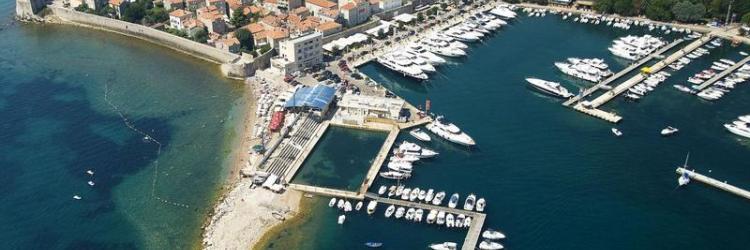Travel destinations Comments: 0 Mar 07, 2016
The coastal area around Budva, called the Budva riviera, is the center of Montenegrin tourism, known for its well preserved medieval walled city, sandy beaches and diverse nightlife. Budva is 2,500 years old, which makes it one of the oldest settlements on the Adriatic coast.
There is vast archaeological evidence that places Budva among the oldest urban settlements of the Adriatic coast. Substantial documentary evidence provides historical references dating back to the 5th century BC. A legend recounts that Bouthoe was founded by Cadmus the founder of Thebes, Greece, when exiled out of Thebes, finding a shelter in this place for him and his wife, Harmonia.
Budva is the administrative centre of Budva municipality, which includes the neighbouring towns of Bečići and Petrovac, and has a population of 19,218. It extends over a length of 38 kilometers, including seventeen beaches of which the most famous are: Jaz, Mogren, the Slovenian beach, Guvance, Becici, Kamenovo, Przno Queen's Beach, Milocer, Perazica Do, Petrovac Beach, Drobni sand, Buljarica and Lucice. In line with its position is characterized by a Mediterranean climate with an average annual temperature of 15.5 ° C. During the summer months, the highest temperature during July and ranges up to 30 ° C, with an average water temperature warmer than 18 ° C.
Budva is connected to inland Montenegro by two-laned highways. There are two ways to reach Budva from Podgorica – either through Cetinje, or through the Sozina tunnel. Either way, Podgorica, the capital and main road junction in Montenegro, is around 60 km away. Budva is connected to the rest of coastal towns of Montenegro by the Adriatic Highway, which extends from Ulcinj in the far south to Herceg Novi in the north, and on to Croatia. Tivat Airport is 20 km (12 mi) away. There are regular flights to Belgrade and Moscow throughout the year, and dozens of seasonal and charter flights land daily on the airport during the summer season. Podgorica Airport is 65 km away, and it has regular flights to a number of European destinations throughout the year.
Many famous personalities are born in Budva: Stefan Mitrov Ljubisa, Konte Zanovic, Anastas Bocaric, Spiro Bocaric i Marko Gregovic.
MAIN TOURIST PLACES IN BUDVA
Old Town
Budva's medieval name was "Civitas Aqua" which means "Old Town". The Old Town of Budva is situated on a rocky peninsula, on the southern end of Budva field. The entire town is encircled with defensive stone walls. The fortifications of Budva are typical of the Medieval walled cities of the Adriatic, complete with towers, embrasures, fortified city gates and a citadel.
The main city gate is Porta di Terra Ferma, the grand entry to the city from the west. It is also the beginning of the city's main thoroughfare, Njegoseva street. The town citadel is situated on the southern tip of the city. Originally known as Castle of St Mary, fortification was continually rebuilt and expanded through Middle Ages, reaching its final form during the Austro-Hungarian rule. Ruins of the Santa Maria de Castello church, after which the entire complex was originally named, are located within the citadel. A large public square is located to the north of the citadel, containing all of the churches of the old town - St. Ivan church (17th century), Santa Maria in Punta (840 AD), and The Holy Trinity church (1804).
The Old Town suffered extensive damage in 1979 earthquake; repair and reconstruction took eight years (until 1987), but traces of the damage are now hardly noticeable. Today, it is a prime visitor attraction of Budva, packed with tourists during the summer months. Its narrow cobbled streets are lined with restaurants, cafes, pubs and shops.
Island of Sveti Nikola
This island, popularly called the "Hawaii" is located one kilometer away from Budva and is believed to have once been connected with the city via a sandbank. It includes three sandy beaches which can be reached only by boat.
During the season day trips are organized to its beaches, where tourists can enjoy the shade of Mediterranean vegetation as well as the specialties of Mediterranean cuisine in the newly opened restaurant. For fans of unexplored regions, this area represents a real challenge with its unique fauna and flora.
Sveti Stefan
Sveti Stefan is a small islet and hotel resort, approximately 6 kilometres southeast of Budva. The resort includes the islet of Sveti Stefan and part of the mainland, where the Villa Miločer part of the resort is located.
An Adriatic playground for the rich and famous from the 1960s to the 1980s, the hotel is now a 5-star franchise hotel of the international group of Aman Resorts, completed in 2009 and operating under a 30-year lease. Formerly an island, Sveti Stefan is now connected to the mainland by a narrow isthmus. The resort in total contains 50 rooms, cottages and suites on the island and 8 grand suites at the Villa Milocer.
Formerly under the ownership of the Radenovic family for some forty years, between the 1960s and 1980s, the place was visited by many celebrities, including Orson Welles, Elizabeth Taylor, Sophia Loren, Arkan, Princess Margaret, Carlo Ponti, Ingemar Stenmarkand Kirk Douglas.
For fans of religious tourism in the area of Budva municipality are monasteries of great importance for the Montenegrin history and culture, among which stand out: Podlastva Monastery, Monastery Podostrog, Stanjevici Monastery, Monastery Duljevo, Praskvica Monastery, Monastery Rezevici and Monastery Gradiste.
The most important cultural events
Festival "Theatre City" (June), Ceremonial New Year's concert of classical music (January), International Carnival (May), Spring Break Festival (June), "Sea Dance Festival" (July), Days of Budva artists (June), "Music of summer "(June), Festival of Children's Theatre "Theatre wave "(August).
Important phone numbers:
Police: 122, Fire Department: 123, Ambulance: 124, Exact time: 125, Telegrams: 126, Information on telephone numbers: 1181.
Popular bus relations with departures from Budva:


 RS
RS  ME
ME  HR
HR  BA
BA  RU
RU  MK
MK  AL
AL  ES
ES  DE
DE  IT
IT  CN
CN  NL
NL  SE
SE  FR
FR 






Write a comment